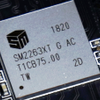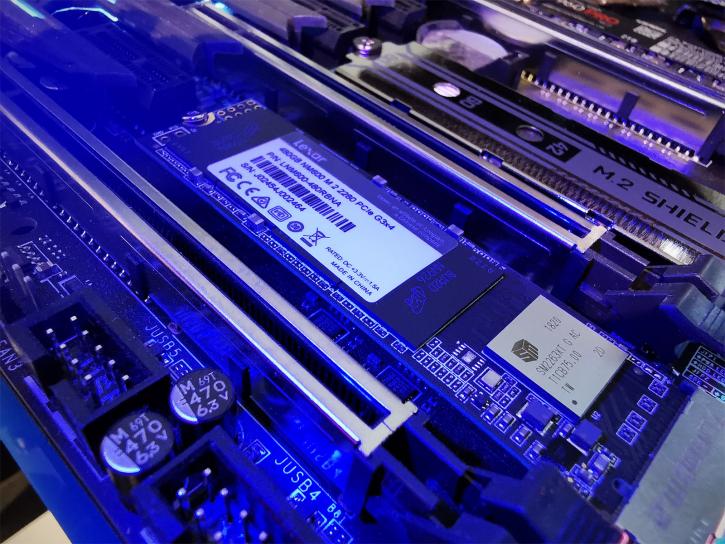Final Words & Conclusion
Final Words & Conclusion
A DRAMless cache design SSD in the year 2019, that normally is not something many would accept. However, on Windows 10, there's a solution. This series uses a PCIe-to NAND controller, and that controller really is the Silicon Motion (SM2263XT). The SM2263XT is a DRAM-less drive, but if you run Windows 10 (2018 Fall Creators or later Update required) Host Memory Buffer technology kicks in, a small chunk of your system memory substitutes the memory of the drive to cache the map table. The SSD stripped from a DRAM cache equals a nice price reduction. The performance, however, did not disappoint even slightly. Reads wise this unit can keep up with enthusiast class NVMe SSDs, writes are a little ickier here and there, but still twice to triple of that compared to a regular SATA3 SSD. So I am inclined to be positive here, however, there is one strong side-note we need to make, the SSD might be cheaper with the DRAM cacheless design, but part of your system memory is used for that, and sure you pay money for your system memory as well right. DDR4 memory sells at roughly 12 EUR/USD per GB. This 500GB SSD uses 512MB of your memory as fast horst cache, realistically and virtually you need to add a price tag of 6 EUR/USD to this SSD. Now I think that is a small price to pay as long as you can spare that 512MB of DDR4 memory overall, ergo this new approach might be extremely cost-effective. But again, Windows 10 is mandatory, patched and updated to the latest revision.
The results mean that this nicely fast performing M.2. unit costs ~15 cents per GB in etail right now. The unit reveals speeds at 2GB/s reads sometimes even closing in at 3 GB/s in specific workloads with close to 1.5 GB/s in writes. The development rate and curve of current NVMe and regular NAND flash-based storage technologies are put exciting.
Flash NAND prices have been coming down, reliability has been top notch and ever so importantly volume sizes have moved upwards to a level where now 1TB SSDs are getting a norm slowly. The current new mainstream is roughly 480/512GB which offers a nice balance in between performance and value. At just over 1 or even 2 GB/s writes per seconds it is easily three times faster compared to that mainstream SATA3 SSD, while topping 3 GB/s reads and thus over quadrupling that number compared to a SATA3 SSD. Combined with a 3-year warranty you should be good to go for a long time. The TBW written values are reasonable as well, 240 TB written for this 480 GB model.
Concluding
If you're on Windows 10 and are all patched up then for me there's little reason to not recommend the Lexar NM600 480GB. You do trade in a small chunk of your system memory (~500MB), ergo that is the dilemma. The trade-in, of course, is good pricing. For most of us, not an issue of course. I can tell you that the controller is impressive, likely even faster than an embedded DRAM chip on an SSD PCB, as our DDR4 memory these days is just so fast. Part of that performance thus is directly tied towards your system memory and it's performance, we tested dual-channel DDR4, now I deliberately configured the memory at JEDEC defaults, that's 2133 MHz. So you now know as well that your memory frequency can never disappoint, it's plenty fast enough for what the SSD controller requires. As you have noticed, given the 480GB file size, there is a bit of SLC partitioned caching and provisioning going on as well. The read performance overall is properly good for a TLC drive, the write performance is a fraction more fragmented, but overall you're bound to see 1 towards 1.5 GB/sec. Once the write buffers run dry, you are left with slow sub 200 MB/sec writes due to that the TLC write hole. If your eyebrows frown right now, please do understand that this only happens after you have written roughly 65GB of data continuously. Unless you have extremely complicated workloads, we just do not see this to be an issue. A DRAMless SSD in the year 2019 that is actually pretty darn good, who would have thought? It works well, and hits a sweet spot in price and performance, of course, mandatory Windows 10 and a small chunk of your system memory is required. If you can find that acceptable and at a decent price we can - recommended, really. We spotted this 480 GB M2 NVMe SSD for $69.99 (USD), it is amazing to see where prices and performance are now compared to what you got in performance and money a few years ago. Lexar tops off this purchase with a three-year warranty.
Recommended Downloads



